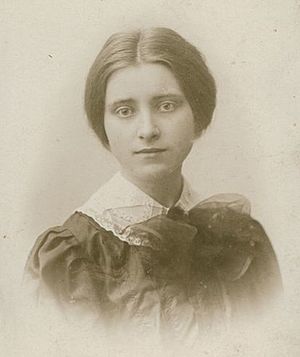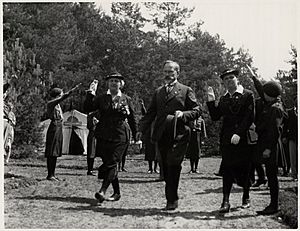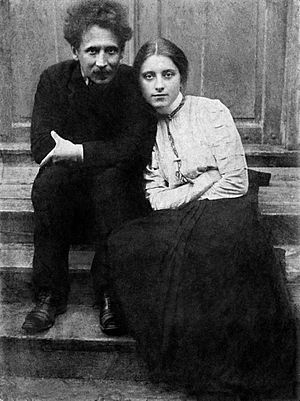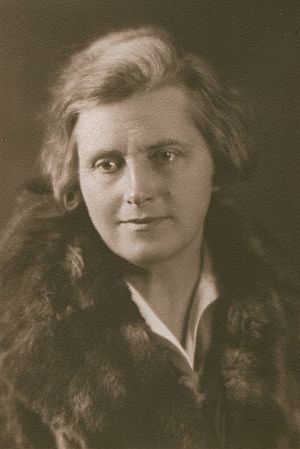Sofija Kymantaitė-Čiurlionienė facts for kids
Quick facts for kids
Sofija Kymantaitė-Čiurlionienė
|
|
|---|---|

Sofija Kymantaitė-Čiurlionienė in 1907
|
|
| Born |
Sofija Kymantaitė
13 March 1886 Joniškis, Kovno Governorate, Russian Empire
|
| Died | 1 December 1958 (aged 72) Kaunas, Lithuanian SSR
|
| Burial place | Petrašiūnai Cemetery |
| Nationality | Lithuanian |
| Alma mater | Jagiellonian University |
| Occupation | Educator, writer, literary critic |
| Employer | Ministry of Defence Vytautas Magnus University |
| Spouse(s) | Mikalojus Konstantinas Čiurlionis |
| Children | Danutė Čiurlionytė-Zubovienė |
| Awards | Order of the Cross of Vytis (1927) Righteous Among the Nations (1991) |
Sofija Čiurlionienė (born Kymantaitė) was a Lithuanian writer, teacher, and activist. She was born on March 13, 1886, and passed away on December 1, 1958.
Sofija studied in cities like Saint Petersburg and Riga. Later, she went to Kraków to study philosophy, literature, and art history at the Higher Courses for Women and Jagiellonian University. In 1907, she returned to Lithuania and became involved in the cultural scene of Vilnius.
In 1909, she married the famous painter and composer Mikalojus Konstantinas Čiurlionis. Sadly, he died in 1911, leaving her with their baby daughter. Sofija became a teacher, working at Vytautas Magnus University from 1925 until 1938. She was also very active in public life. She represented Lithuania at the League of Nations and led the Lithuanian girl scouts. During World War II, she bravely helped save Jewish people from the Kovno Ghetto. For her actions, she was honored as Righteous Among the Nations in 1991.
Sofija wrote many essays about art and literature. She often supported symbolism, which looks for deeper meanings, over realism. Her most popular works were plays, especially comedies like Pinigėliai (Money) and Vilos puošmena (Decoration of a Villa). She also wrote dramas, poems, and stories about the Lithuanian press ban and the Lithuanian National Revival.
Contents
Sofija's Life Story
Growing Up and Learning
Sofija Kymantaitė was born on March 13, 1886, in Joniškis. Her family was part of the Lithuanian nobility, but they didn't own land. She lived with her uncle, a Catholic priest named Vincentas Jarulaitis, who taught her at home and helped pay for her schooling.
When Sofija was young, her family moved to Kuliai. In 1898, she started school in Palanga. That same year, she met priest Juozas Tumas-Vaižgantas, who was a big part of the Lithuanian National Revival. He taught her to read and write in Lithuanian. In 1899, she saw the first Lithuanian play in Lithuania called America in the Bathhouse.
From 1899 to 1904, Sofija studied at girls' schools in Saint Petersburg and Riga. In Riga, she joined a secret Lithuanian student group. She continued to learn Lithuanian from Marcelinas Šikšnys and often visited the family of writer Pranas Mašiotas, where she shared her first poems.
Studying in Kraków
From 1904 to 1907, Sofija studied in Kraków, which was then part of Austria-Hungary. She attended the Higher Courses for Women and the Jagiellonian University. She wanted to study medicine at first, but she didn't know Latin. So, she chose to study philosophy, literature, and art history instead.
In Kraków, she met Polish painters and learned from famous teachers. She also joined a Lithuanian society called Rūta and started writing articles about Lithuanian literature. Her first long study about poets was published in 1906.
When her uncle could no longer support her studies, Sofija returned to Lithuania in 1907. She joined the cultural life in Vilnius. She worked for the newspaper Viltis (Hope) and wrote articles about Lithuanian literature. She also got more lessons in Lithuanian from important teachers. Sofija attended the First Congress of Lithuanian Women in 1907 and spoke about teaching Lithuanian history. She also acted in plays, showing her talent in the arts.
Her Marriage to Čiurlionis
Sofija met Mikalojus Konstantinas Čiurlionis at an art exhibition in January 1907. They met again later that year, and he asked her to teach him Lithuanian. She agreed, and they spent time together learning and getting to know each other.
In the summer of 1908, they decided to get married. They wed on January 1, 1909. The couple moved to Saint Petersburg to help Čiurlionis with his art career. They later returned to Lithuania for the summer. In the fall of 1909, Čiurlionis went back to Saint Petersburg alone. When Sofija visited him, she found him very unwell. He was placed in a special care home near Warsaw.
Sofija stayed in Lithuania and gave birth to their daughter, Danutė, on June 12, 1910. Sadly, Čiurlionis never saw his daughter. He became ill and passed away on April 10, 1911.
Even though their time together was short, Sofija and Čiurlionis worked on several projects. They helped organize the Second Lithuanian Art Exhibition and published a book of literary criticism. They also influenced each other's art. Čiurlionis's paintings became very famous in Lithuania. In 1922, Sofija sold 193 of his works to the government, and the money was saved for their daughter.
A Teacher and Public Servant

After her husband's death, Sofija, at 25 years old, moved to Kaunas with her daughter. She became a teacher at courses for teachers, teaching Lithuanian language and literature. She also wrote plays that were performed to help raise money for students.
During World War I, she moved to Voronezh and continued teaching Lithuanian. Because there weren't many Lithuanian textbooks, she created and published her own collections of articles and textbooks.
In 1919, she returned to Kaunas and worked for the Ministry of Defence. From 1925 to 1938, she taught Lithuanian at Vytautas Magnus University. In 1935, the university sent her to Europe to learn the best ways to teach language and literature. She visited Switzerland, France, and Poland.
Sofija was also very active in public life. In 1929, she attended a meeting of the Women's International League for Peace and Freedom (WILPF) in Vienna. She spoke up for Lithuania's claims to the Vilnius Region. She also became a member of Lithuania's group at the League of Nations from 1929 to 1931 and again from 1935 to 1938. She worked on committees dealing with social and humanitarian issues.
In 1929, she started a group in Lithuania called "Mergaičių bičiulių draugija" (Friends of Young Women). This group helped young women who moved from villages to cities to make sure they were safe and not taken advantage of.
From 1930 to 1936, Sofija was the leader of the Lithuanian girl scouts. From 1926 to 1942, she held Saturday gatherings at her home. Many famous writers, poets, and linguists came to these meetings. These gatherings led to the creation of a magazine called Gimtoji kalba (Mother Tongue), which Sofija edited for its first year. She also wrote many articles about language, education, and culture for different magazines.
Later Years and Helping Others
Due to her health, Sofija stopped teaching in 1938, but she still gave guest lectures. During World War II, she and her family helped save Esther, a one-year-old Jewish girl, from the Kovno Ghetto. They worked with Petras Baublys, who ran an orphanage, to save many children and others. In 1991, they were recognized as Righteous Among the Nations for their brave actions.
In 1954, Sofija wrote to Justas Paleckis, a high-ranking official, to ask for help for Juozas Urbšys, who was the last Foreign Minister of independent Lithuania, and his wife. They had been imprisoned in Siberia and were not allowed to return to Lithuania. Sofija asked for them to be allowed back and offered them a place to live in her home. They returned in 1956 and lived with her. To earn money, Urbšys translated books from French, and these translations were often credited to Sofija.
Sofija Čiurlionienė passed away in 1958 after two heart attacks. She was buried in the Petrašiūnai Cemetery.
Sofija's Writings
Sofija's first literary works, a poem and an impression, were published in 1907. She later published her stories and critical essays in various collections and magazines.
Her first book, Lietuvoje (In Lithuania), came out in 1910. It included her essays and one essay on music by Čiurlionis, which she translated. In this book, she looked closely at Lithuanian culture and society. She was influenced by ideas from the fin de siècle and Young Poland movements. She didn't like realism, which was common then, and preferred symbolism. Symbolism aimed to find deeper meanings and explore spiritual life. In her essays, she encouraged artists to look inside themselves and to explore the Lithuanian spirit found in Lithuanian folklore, rather than just copying foreign styles.
Most of Sofija's literary works are plays, making her one of the first Lithuanian women playwrights. Her first play was Kalinys (Prisoner), about the escape of Grand Duke Vytautas. Her most popular plays were the comedies Pinigėliai (Money; 1919) and Vilos puošmena (Decoration of a Villa; 1932). These comedies used humor to show society's problems, like greed and the desire for money. Another comedy, Didžioji mugė (The Great Fair; 1939), explored the lives of wealthy families. Her drama Aušros sūnūs (Sons of Aušra; 1922) showed the lives of Lithuanian book smugglers during the Lithuanian press ban. In 1941, she wrote the drama Tie metai (That Year) about the first Soviet deportation from Lithuania. She also wrote plays for school theaters.
Her works were greatly influenced by Lithuanian folklore. For example, her poem Giria žalioji (The Green Forest), the children's play Dvylika brolių, juodvarniais laksčiusių (Twelve Brothers Flying as Ravens), and the poem Mūsų jauja (Our Barn) all used plots, symbols, and myths from Lithuanian folktales.
Her autobiographical novel Šventmarė (1937) is an example of literary realism, even though she often criticized realism. It describes a parish in Samogitia during the Lithuanian press ban, showing the social and cultural life of that time. The novel Bundanti žemė (Awakening Earth; 1913–1934) also explores the National Revival, following two young friends from different backgrounds who become involved in cultural work. She also wrote some works in the Samogitian dialect.
Sofija also translated French comedies like Tartuffe and The Miser by Molière. She also helped translate and edit the Greek epic Iliad.
Sofija's Legacy
Sofija Čiurlionienė's selected works were published in three volumes in 1956 for her 70th birthday. A larger collection of her works in eight volumes was published from 1986 to 2013. Several books have been written about her life. Her only daughter also published two books of memories about her mother. Many artists painted her portraits.
Sofija burned her letters to her husband Čiurlionis, but his letters to her were published in 1973 and again in 2011. A movie about their love story, Letters to Sofija, was released in 2013. She is also shown in plays and films. In 2017, an annual art and music festival named Sofija was started in her honor.
In 1932, Sofija moved into her own house in Kaunas. This house was designed by architect Vytautas Landsbergis-Žemkalnis and was paid for with money from the sale of Čiurlionis's paintings. It is a great example of modernist architecture in Kaunas, which has received the European Heritage Label. Her room in the house has been kept as a memorial, showing her original furniture, books, and personal items. It opened to the public in 1971.
The house where she and Čiurlionis stayed in Palanga is now a protected cultural site, and a memorial plaque was placed there in 1969. A street in Aleksotas, a part of Kaunas, was named after her in 1993. The house where Sofija was born in Joniškis was identified in 2016, and photos of her were put on its outside in 2019.
Images for kids
-
Čiurlioninė (left) with President Antanas Smetona at a scout's camp in July 1938







